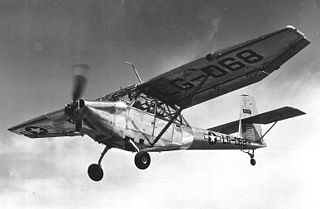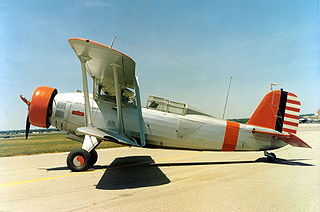
The Martin B-10 was the first all-metal monoplane bomber to be regularly used by the United States Army Air Corps, having entered service in June 1934. It was also the first mass-produced bomber whose performance was superior to that of the Army's pursuit aircraft of the time.

The Douglas C-47 Skytrain or Dakota is a military transport aircraft developed from the civilian Douglas DC-3 airliner. It was used extensively by the Allies during World War II. During the war the C-47 was used for troop transport, cargo, paratrooper, for towing gliders and military cargo parachute drops. The C-47 remained in front-line service with various military operators for many years. It was produced in approximately triple the numbers as the larger, much heavier payload Curtiss C-46 Commando, which filled a similar role for the U.S. military.

The Curtiss A-12 Shrike was the United States Army Air Corps' second monoplane ground-attack aircraft, and its main attack aircraft through most of the 1930s. It was based on the A-8, but had a radial engine instead of the A-8's inline, water-cooled engine, as well as other changes.

The Stinson L-13 is a US military utility aircraft first flown in 1945.

The Bell 47 is a single-rotor single-engine light helicopter manufactured by Bell Helicopter. It was based on the third Bell 30 prototype, which was the company's first helicopter designed by Arthur M. Young. The 47 became the first helicopter certified for civilian use on 8 March 1946. The first civilian delivery was made on 31 December 1946 to Helicopter Air Transport. More than 5,600 Bell 47s were produced, including those under license by Agusta in Italy, Kawasaki Heavy Industries in Japan, and Westland Aircraft in the United Kingdom. The Bell 47J Ranger is a modified version with a fully enclosed cabin and tail boom.

The Grumman FF "Fifi" is an American biplane fighter aircraft operated by the United States Navy during the 1930s. It was the first carrier aircraft with retractable landing gear. It was produced under licence in Canada and known as the Goblin in Canadian service and Delfín in Spanish service.

The Douglas O-38 is an observation airplane used by the United States Army Air Corps in the 1930s and early 1940s.

The Curtiss O-52 Owl is an observation aircraft used by the United States Army Air Corps before and during World War II. They were used for anti-submarine searches in Americas and by lend-lease also used on the Eastern Front in Europe by the Soviets.

The Curtiss F11C Goshawk is an American naval biplane fighter aircraft that saw limited success. It was part of a long line of Curtiss Hawk airplanes built by the Curtiss Aeroplane and Motor Company for the American military.

The Curtiss XA-14 was a 1930s United States airplane, the first multi-engine attack aircraft tested by the United States Army Air Corps. Carrying a crew of two, it was as fast as the standard pursuit aircraft in service at the time.

The Curtiss A-18Model 76A Shrike II was a 1930s United States twin-engine ground-attack aircraft. It was the production test version of that company's A-14 Shrike.

The Aeronca L-3 group of observation and liaison aircraft were used by the United States Army Air Corps in World War II. The L-3 series were adapted from Aeronca's pre-war Tandem Trainer and Chief models.

The Aeronca L-16 is a United States Army liaison aircraft built by Aeronca. It saw extensive service during the Korean War. It was essentially a militarized version of the Aeronca Champion. From 1955 large numbers were transferred to the Civil Air Patrol.

The Douglas O-43 was a monoplane observation aircraft used by the United States Army Air Corps.

The Consolidated PT-1 Trusty is a biplane primary trainer used by the United States Army Air Service (USAAS) in the 1920s.

The Curtiss BF2C Goshawk was a United States 1930s naval biplane aircraft that saw limited success and was part of a long line of Hawk Series airplanes made by the Curtiss Aeroplane and Motor Company for the American military, and for export as the Model 68 Hawk III.

The Consolidated O-17 Courier was an observation and training aircraft used by the United States National Guard.

The Consolidated Model 2 was a training airplane used by the United States Army Air Corps, under the designation PT-3 and the United States Navy under the designation NY-1.

The Fairchild AT-21 was an American World War II specialized bomber crew trainer, intended to train crews in the use of power gun turrets or a gun on a flexible mount, as well as learn to function as a member of a crew. It had a brief career as a training aircraft before modified bombers took over this role.

The Consolidated P2Y was an American sesquiplane maritime patrol flying boat. The aircraft was also made by Martin as the P3M, as a parasol monoplane, due to the Navy awarding production contracts separately from prototype contracts.























